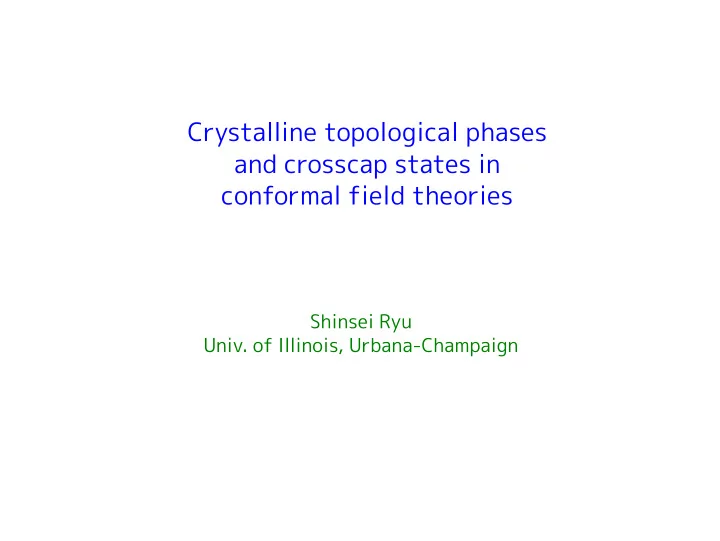

Crystalline topological phases and crosscap states in conformal field theories Shinsei Ryu Univ. of Illinois, Urbana-Champaign
People and papers Bode Sule (UIUC) Chang-Tse Hsieh (UIUC) Xiao Chen (UIUC) Ching-Kai Chiu (UIUC -> UBC) Takahiro Morimoto (RIKEN) Hong Yao (Tsinghua) Shou-Cheng Zhang (Stanford) Rob Leigh (UIUC) Gil Young Cho (UIUC) SR and Shou-Cheng Zhang, PRB (2012). H. Yao and SR, PRB (2013) C.K. Chiu, H. Yao, SR, PRB (2013) O. M. Sule, X. Chen, and SR, PRB (2013) C.-T. Hsieh, T. Morimoto, SR, PRB (2014) C.-T. Hsieh, O. M. Sule, G. Y. Cho, SR and R. G. Leigh, PRB (2014)
- Introduction - Warmup: IQHE and QSHE - Non-on-site symmetry, Crystalline topological insulators/SC - Crystalline topological SC and interaction effects
"Sick" theories - Chiral edge of QHE bulk QHE - Helical edge of QSHE surface - Surface of 3d topological insulators bulk (insulator)
What's "sick" about them? - (Partial) answers: They cannot be gapped (while preserving symmetries)! "Ingappable" They completely evade Anderson localization! ... --> Indicative of the absence of "atomic limit" --> These theories cannot be put on a lattice! (no-go theorem) --> Only possible chance: they live on a boundary of a higher-dimensional topological system
Laughlin's gauge argument edge 2 edge 1 - Adiabatic process - When system goes back to itself ("large gauge equivalent") - However, by this adiabatic process, an integer multiple of charge is transported from the left (right) to right (left) edge. - Charge is not conserved for a given edge.
Topological phases and anomalies Topological phases (in broad sense): no analogous phase in classical systems (very quantum state of matter) Anomalies: breakdown of a classical symmetry by quantum effects (nothing is more quantum than this) - A close relation known as bulk-boundary correspondence - Advantage: - Robust against interactions, e.g., Adler-Bardeen's theorem - Observable: anomaly = "response" Operational definition of topological phases
Laughlin's argument revisted - Chiral edge theory - Twisted boundary condition - Ground state with twisted bc ("twisted sector GS"): - "State-operator correspondence" : "twist operator" - The GS fermion number :
"QSHE" with conserved S z - Non-chiral edge theory - Twisted boundary condition by charge: - Twisted sector GS: - Twisted BC is invariant under S z: - The GS is not:
Lessons: - Symmetries in QFTs can be twisted. - Once twisted, symmetry is "bulit-in" -- it is a part of the theory. Symmetry --> twist operator (convenient in studying SPTs) - Twist operator or twisted sector GS may show anomalous behavior E.g. Twisted theory may fail to be modular invariant E.g. Twist operators may show fractional statistics
SPT phases protected by spatial symmetries - Onsite v.s. non-onsite symmetries. This talk: non-onsite symmetries E.g., Parity symmetry. Topological crystalline insulators Topological crystalline superconductor - Is there an anomaly characterizing crystalline topological insulators and superconductors ? - Proposed scheme --> "Orientifold" field theory (Edge) theories defined on non-orientalble space-time
Periodic table with reflection symmetry Chiu-Yao-SR (2013) Morimoto-Furusaki (2013) Shiozaki-Sato (2014) ... - Systematic classification with reflection symmetry for non-interacting cases
Topological crystalline superconductors - Topological superconductor protected by parity (P) bulk - Edge BdG Hamiltonian: - P symmetry - Can check no mass terms are allowed. Classification: Z 2 - With additional TRS, classification is Z - How about interactions ? Z --> Z 8
CP symmetric topological insulator - System with CP and charge U(1) symmetries bulk "CPT-dual" of QSHE - Edge Hamiltonian: - CP symmetry - Can check no mass terms are allowed when topological. - How about interactions ?
Twisting boundary conditions time Twisting by on-site symmetry space Twisting by parity symmetry
Twisting symmetry -- general strategy twist operator "time" time ("anyon") Twisted B.C. "Twist state"
Crosscap and crosscap state - Twisting b.c. by parity: - Klein bottle = sphere with two crosscap - Finding a nice time slice --> "Crosscap" state |C>:
Anomalous crosscap states - Crosscap condition: circumference: c.f. Twisted sector ground state - Symmetry G acting on crosscap [e.g. G= U(1)] - When U and U G commute, crosscap condition is invariant but crosscap state may not be! - Related to the anomalous phase of the partition function
physical degrees of freedom MPS (matrix product state) : auxiliary index
Analysis and result - Symmetry group: - Crosscap condition: twist by P twist by P x G f - Symmetry action on fermion number parity: "anomalous" relative phase - Anomalous relative sign goes away for 2N copies --> Z 2 - With time reversal: anomalous pi/2 relative phase --> Z 4 ??
Summary - Formulated Laughlin's argument for SPTs protected by parity and other symmetries - Topology change from Torus to Klein - Symmetry properties of crosscap states - Reproduced expected Z 2 classification in all known cases - Z 4 v.s. Z 8 ?
Recommend
More recommend